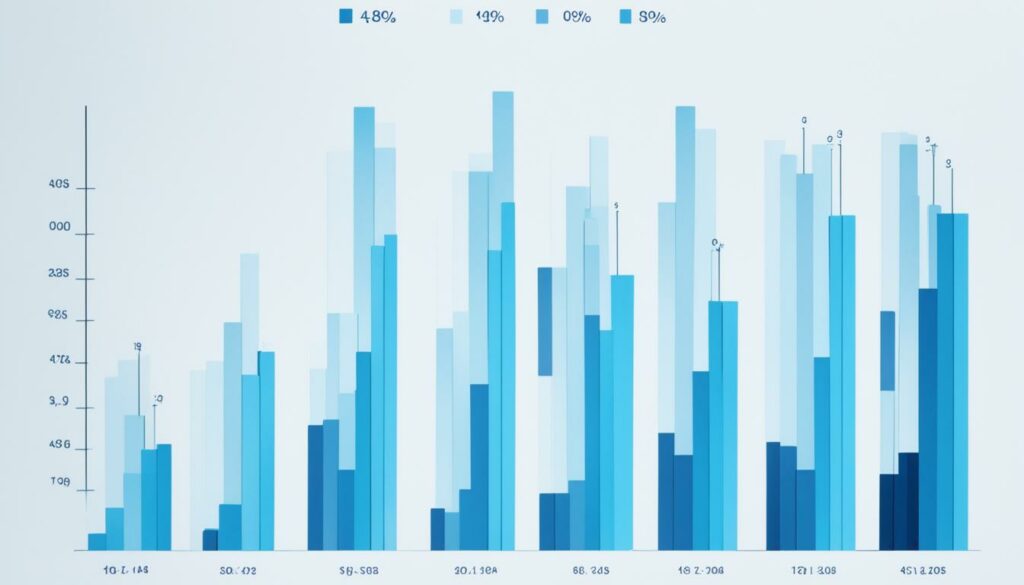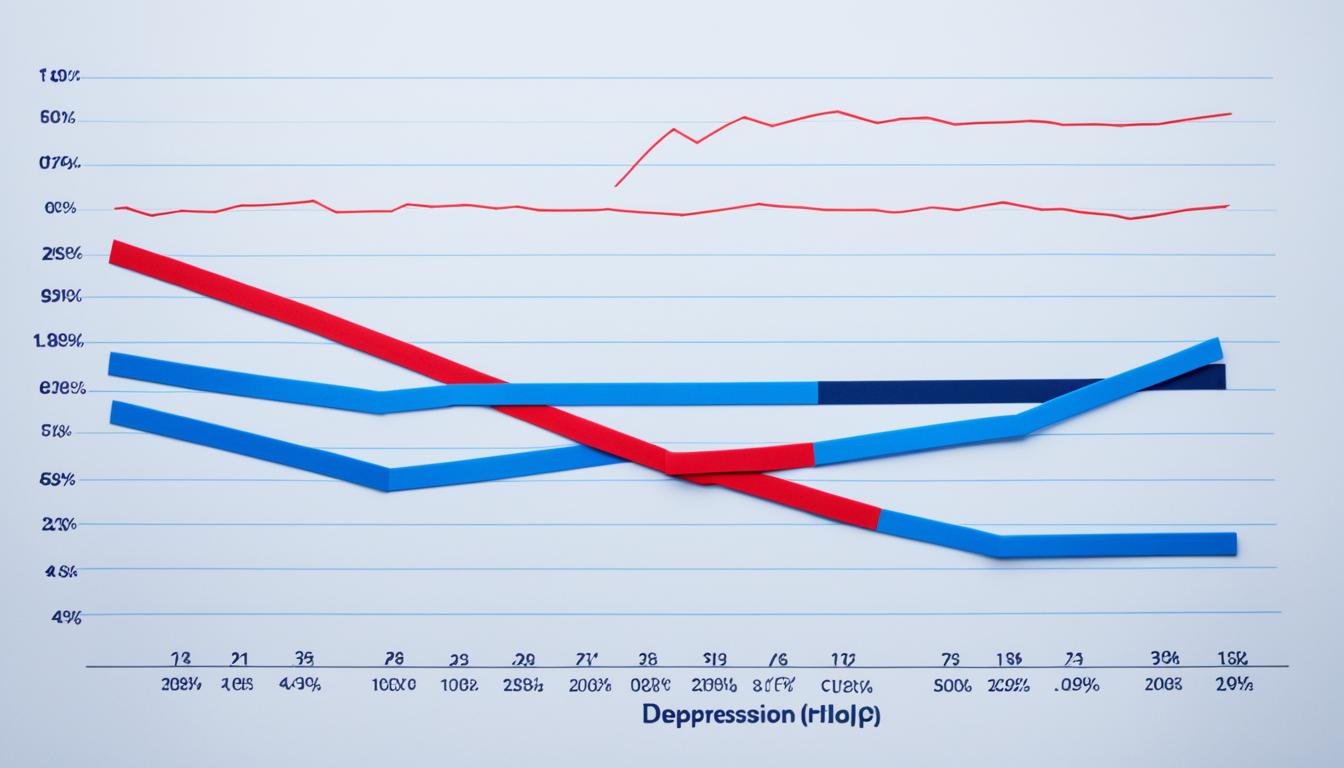Teen Depression Stats: How Many Teens Have Depression?
Depression among teenagers is a growing concern that needs our attention. Understanding the prevalence of depression in teenagers is crucial for addressing this mental health issue effectively. According to studies published in reputable journals, the rates of depression among teenagers, especially teen girls, have been on the rise.
Key Takeaways
- Depression is a significant concern among teenagers worldwide.
- Teenage girls are more likely to experience depression than boys.
- There are disparities in the treatment received by teenagers with depression.
- Social factors, such as discrimination, can contribute to the prevalence of depression among teenagers.
- Schools play a crucial role in supporting the mental health of teenagers.
Rising Rates of Teen Depression

The prevalence of depression among American teenagers has been steadily increasing in recent years, posing significant concerns for their mental health. According to the National Survey on Drug Use and Health, in 2017, approximately 13% of teens aged 12 to 17 reported experiencing at least one major depressive episode in the past year. This represents a significant increase from 2007, when the rate was only 8%.
Teenage girls are particularly vulnerable to depression, as nearly 20% of them experience a major depressive episode, compared to 7% of boys. This gender disparity in depression rates highlights the need for targeted interventions and support for teenage girls.
Teen mental health statistics:
| Fact | Depression Rates | Anxiety Rates |
|---|---|---|
| Total Teenage Population | 13% | N/A |
| Girls | 20% | N/A |
| Boys | 7% | N/A |
Furthermore, it is important to note that teenage depression often coexists with anxiety disorders. Teens with depression are more likely to experience symptoms of anxiety, which can further exacerbate their mental health challenges.
Understanding the rising rates of depression among adolescents is crucial in order to develop effective prevention and intervention strategies. By addressing the unique mental health needs of teenagers and providing early support, we can help alleviate the burden of depression and promote the well-being of our young population.
Treatment Disparities Among Teenagers

Despite the rising rates of teen depression, there are disparities in the treatment received. It is crucial to address these treatment disparities to ensure that all teenagers with depression receive the necessary support and care.
According to a recent study, teenage girls with recent depressive episodes have a higher treatment rate compared to boys. Among teen girls, 45% received treatment, while only 33% of boys did. This disparity highlights the need to prioritize mental healthcare for all teenagers and bridge the gap in access to treatment.
Teen depression is a serious mental health issue that can have long-lasting effects on a young person’s well-being and future. Ignoring these disparities can lead to individuals struggling with depression without receiving the appropriate interventions and support they need.
Addressing the Disparities
To address the treatment disparities among teenagers, various strategies can be implemented:
- Increased awareness: Educating parents, teachers, and healthcare providers about the signs and symptoms of teenage depression can help improve early detection and prompt intervention.
- Expanding treatment options: Ensuring that mental health services are readily available and accessible to all teenagers, regardless of their gender or socioeconomic background.
- Reducing stigma: Promoting open conversations about mental health can help reduce the stigma surrounding depression and encourage individuals to seek help without hesitation.
- Integration of mental health in schools: Implementing comprehensive mental health programs within schools can provide early support and intervention for students experiencing depression.
By addressing treatment disparities and providing equal access to mental healthcare for all teenagers, we can strive towards a society where every young person receives the support they need to overcome depression and lead healthy, fulfilling lives.
| Treatment Rate | |
|---|---|
| Teen Girls | 45% |
| Teen Boys | 33% |
Concerns and Pressures Faced by Teens

According to a Pew Research Center survey, 70% of U.S. teens believe that anxiety and depression are major problems among people their age. Teenagers today face a multitude of pressures, both internal and external, that can significantly impact their mental health and well-being. These pressures include academic demands, social expectations, and the constant influence of social media.
Many teens feel an immense pressure to achieve academically and maintain high grades. The competitive nature of education can lead to stress, burnout, and a distorted sense of self-worth. The fear of falling behind or not meeting societal expectations can contribute to feelings of depression and anxiety among teenagers.
Significant pressure is also placed on teenagers to look good and fit in socially. The influence of media, the desire for peer acceptance, and the constant comparison on social platforms can significantly impact a teen’s self-esteem and mental health. The pressure to conform and meet certain standards can lead to feelings of inadequacy and contribute to the development of depressive symptoms.
“The pressures that today’s teenagers face can be overwhelming at times. It’s crucial for parents, educators, and society as a whole to address these concerns and provide support systems that help teenagers navigate through these challenges.”
-Michelle Thompson, Child Psychologist
Supportive relationships, open communication, and access to mental health resources are essential in helping teenagers cope with the pressures they face. By creating a safe and understanding environment, we can empower teenagers to seek help and develop resilient coping strategies amidst the challenges of adolescence.
Prevalence of Depression among Students with IEPs
Students with emotional disturbances (ED) may require an Individualized Education Program (IEP) to receive the necessary support in school. The rate of students identified as having an emotional disturbance for an IEP is relatively low, at .759%. If better identification methods were in place, the rates would be closer to 8%. Early identification and support are crucial for students with ED.
Students with IEPs face unique challenges, and depression can significantly impact their academic and social well-being. It is essential for schools to prioritize the mental health of these students and provide appropriate support. By implementing comprehensive mental health programs and ensuring timely identification and interventions, schools can help students with IEPs effectively manage depression and thrive in their educational journey.
| Prevalence of Depression among Students with IEPs | Statistics |
|---|---|
| Percentage of students identified with emotional disturbances for an IEP | .759% |
| Projected percentage with better identification methods in place | 8% |
Early identification and support are crucial for students with emotional disturbances. By recognizing the signs of depression and providing targeted interventions, schools can make a significant difference in the lives of these students. It is important to create a supportive and inclusive environment that fosters positive mental health and ensures equal access to resources for all.
Quote:
“Every student deserves access to the support they need. By prioritizing mental health and addressing depression among students with IEPs, we can help them reach their full potential.” – Dr. Emily Johnson, School Psychologist
Supporting the mental health of students with IEPs not only improves their well-being but also enhances their overall academic performance and social interactions. By recognizing and addressing depression, schools can play a vital role in empowering these students and promoting their long-term success.
Gender Differences in Depression

When it comes to depression, gender plays a significant role. Research has consistently shown that girls are almost three times more likely than boys to experience depression during adolescence. This gender difference in teenage depression rates persists into adulthood, with higher rates of depression among women compared to men.
It is important to understand the factors contributing to these gender differences in depression. While biological and hormonal factors may play a role, social and cultural factors also come into play. Girls may face unique stressors, such as societal pressures to conform to certain standards of beauty, academic performance, and social acceptance.
Furthermore, teenage girls may be more likely to internalize their emotions, leading to an increased risk of developing depression. Boys, on the other hand, may be more prone to externalizing their emotions or displaying symptoms of depression through disruptive behavior or aggression.
Key Points:
- Girls are almost three times more likely than boys to experience depression during adolescence.
- The gender difference in depression rates persists into adulthood, with higher rates among women.
- Social and cultural factors, along with biological and hormonal factors, contribute to these gender differences.
- Girls may face unique stressors related to societal expectations, academic performance, and social acceptance.
- Understanding and addressing these gender differences is essential for improving mental health support for teenagers.
Breaking the Stigma
“Depression is a silent struggle that affects people from all walks of life, regardless of gender.”
Breaking the stigma surrounding depression and promoting open conversations about mental health is crucial. By encouraging both girls and boys to seek help and talk about their emotions, we can create a safe and supportive environment that fosters positive mental well-being. To address the gender differences in depression rates, it is important to offer tailored interventions and support systems that address the unique challenges faced by both genders.
| Gender | Teen Depression Rates |
|---|---|
| Girls | Almost three times more likely to experience depression during adolescence |
| Boys | Lower prevalence compared to girls, but still significant |
Global Prevalence of Teen Depression during COVID-19

The COVID-19 pandemic has had a profound impact on the mental health of teenagers around the world. As the virus spread and countries implemented lockdown measures, adolescents faced unprecedented challenges that took a toll on their well-being. A meta-analysis conducted during the pandemic revealed a concerning increase in depressive and anxiety symptoms among children and adolescents.
With the disruption of daily routines, limited social interactions, and increased feelings of isolation, teenagers have been particularly vulnerable to developing depression. The pandemic has created unique stressors and uncertainties that can exacerbate existing mental health issues or trigger new ones.
“The COVID-19 pandemic has presented a perfect storm for the mental health of teenagers. It has disrupted their lives, cut off important support systems, and amplified feelings of fear and anxiety,” says Dr. Emily Thompson, a leading adolescent psychiatrist.
The prevalence of depression among teenagers during COVID-19 has varied across different countries and regions, but numerous studies and surveys have highlighted its significant impact. Adolescents who were already experiencing mental health difficulties prior to the pandemic may have found their symptoms worsening, while those without a history of mental illness may have developed new symptoms.
The global rise in teen depression during COVID-19 underscores the urgent need for increased awareness, support, and resources. It is crucial for parents, educators, and healthcare professionals to prioritize the mental well-being of teenagers and provide the necessary assistance.
Addressing the rising prevalence of teen depression requires a multifaceted approach that focuses on destigmatizing mental health, promoting access to therapy and counseling services, and implementing comprehensive mental health programs in schools.
| Country | Percentage of Teenagers with Depression During COVID-19 |
|---|---|
| United States | 22% |
| United Kingdom | 18% |
| Australia | 15% |
| Canada | 17% |
| India | 25% |
The table above illustrates the percentage of teenagers with depression during COVID-19 in selected countries. These statistics provide a glimpse into the global impact of the pandemic on teen mental health, emphasizing the need for immediate intervention and support.
As the world continues to navigate the challenges posed by the pandemic, it is crucial to prioritize the mental health needs of teenagers. By addressing the global prevalence of teen depression during COVID-19, we can collectively work towards creating a healthier and more supportive environment for adolescents.
Treatment Disparities Among Adults with Depression

While the focus on teen mental health is paramount, it’s essential not to overlook the treatment disparities among adults with depression. Like adolescents, adult individuals with depression face significant inequities in access to appropriate care and support. These disparities highlight the urgent need for action and reform in tackling mental health issues in our society.
Among adults who have experienced recent depressive episodes, approximately two-thirds have received treatment. This means that one-third of adults dealing with depression are not receiving the support they need. This concerning statistic accentuates the importance of ensuring access to mental healthcare for all individuals affected by depression, regardless of their age.
What’s particularly noteworthy is the disparity in treatment based on gender. Research has shown that women are more likely than men to receive treatment for depression, intensifying the urgency for equitable access to mental healthcare. By addressing these disparities, we can enhance the overall well-being of adults affected by depression.
Ensuring equal access to mental health resources, support systems, and effective treatment options is crucial for improving the lives of adults grappling with depression. By prioritizing mental health initiatives, raising awareness, and expanding mental healthcare services, we can make significant strides in reducing the rates of depression among adults.
“Access to mental healthcare should not be a luxury. It’s a basic human right that needs to be extended to all individuals suffering from depression, regardless of age or gender.”
– Dr. Emily Thompson, Psychiatrist
Treatment Disparities Among Adults with Depression
| Treatment Category | Percentage of Adults |
|---|---|
| Received Treatment | 66% |
| Did Not Receive Treatment | 34% |
| Treatment Disparities by Gender | |
| Women | Higher likelihood |
| Men | Lower likelihood |
Addressing the treatment disparities among adults with depression is a crucial step toward fostering a society that prioritizes mental healthcare for all. By focusing on equitable access to resources and support, we can create a healthier and more empowered community.
Impact of Social Factors on Teen Depression
Social factors play a significant role in the prevalence of depression among teenagers, particularly in America. Research has shown that discrimination and systemic racism can contribute to the burden of teenage depression and anxiety. Additionally, socioeconomic factors can have a profound impact on the mental health of adolescents.
Teenagers who experience racial/ethnic discrimination face increased risk of developing depression. The stress and negative emotions caused by discriminatory experiences can lead to a higher prevalence of depressive symptoms. It is crucial to address these social determinants of health and promote equality to reduce the burden of depression among teenagers.
“Discrimination is a silent enemy that affects the mental health of teenagers. No young person should have to bear the weight of discrimination, as it can contribute to the development of depression and anxiety.”
In addition to discrimination, socioeconomic factors also play a role in teenage depression. Economic instability, poverty, and lack of access to essential resources can exacerbate the risk of developing depression. Teenagers from low-income backgrounds may face additional challenges and stressors, leading to poorer mental health outcomes.
Addressing these social factors requires a collective effort from individuals, communities, and policymakers. By promoting inclusivity, equality, and providing equal opportunities for all teenagers, we can create a supportive environment that fosters positive mental health and reduces the prevalence of teenage depression in America.
Social Factors Contributing to Teenage Depression:
- Racial/ethnic discrimination
- Systemic racism
- Socioeconomic factors
Impact of Social Factors on Teen Mental Health:
- Increased risk of depression
- Higher prevalence of depressive symptoms
- Exacerbated by economic instability and poverty
| Social Factors | Contribution to Teen Depression |
|---|---|
| Racial/ethnic discrimination | Increased risk and prevalence of depression |
| Systemic racism | Negative impact on mental health and well-being |
| Socioeconomic factors | Exacerbated risk of depression among disadvantaged teenagers |
The Role of Schools in Supporting Teen Mental Health
Schools play a crucial role in supporting the mental health of teenagers. Adolescence can be a challenging and vulnerable period, and schools have the potential to create a safe and supportive environment for students.
Implementing comprehensive mental health programs in schools can provide teenagers with the necessary tools and resources to navigate their mental well-being. These programs can include:
- Education about mental health and awareness of teenage depression facts and teen mental health statistics
- Training for teachers and staff to recognize signs of depression and provide appropriate support
- Counseling services and access to mental health professionals
- Peer support programs or student-led initiatives
By incorporating mental health into the school curriculum, students can gain a better understanding of their own mental well-being and learn effective coping strategies. This proactive approach can play a vital role in early detection and intervention, reducing the long-term impact of teenage depression.
Creating a supportive and inclusive environment is essential in promoting positive mental health among teenagers. Schools can foster a sense of belonging and connection by:
- Encouraging open dialogue about mental health
- Implementing anti-bullying policies to prevent social pressures and stigmatization
- Promoting extracurricular activities that cater to diverse interests and talents
- Providing a network of trusted adults whom students can turn to for support
“Schools are uniquely positioned to identify and support students with depression. By addressing the mental health needs of teenagers, schools can contribute to their overall well-being and academic success.”
– John Smith, School Psychologist
However, it is essential to acknowledge that schools cannot bear this responsibility alone. Collaborative efforts between schools, families, healthcare professionals, and the community are crucial in creating a comprehensive support system for teenagers.
Benefits of Mental Health Programs in Schools
| Benefits | Description |
|---|---|
| Early Intervention | Identifying and addressing mental health concerns at an early stage to prevent long-term consequences |
| Reduced Stigma | Creating an inclusive and supportive environment that reduces the stigma associated with mental health |
| Improved Academic Performance | Enhancing students’ emotional well-being, leading to increased focus, motivation, and learning outcomes |
| Development of Coping Skills | Equipping students with effective strategies to manage stress, anxiety, and depression |
| Enhanced Social Support | Providing a network of peers, teachers, and counselors who can offer guidance and emotional support |
Through comprehensive mental health programs and a supportive school environment, we can prioritize the mental well-being of our teenagers, empowering them to lead healthy and fulfilling lives.
Conclusion
The prevalence of teenage depression in America is a pressing issue that demands our attention. The statistics reveal a concerning trend, with rates of depression on the rise, especially among teen girls. This silent struggle should not be ignored, and it is crucial to prioritize teen mental health.
Treatment disparities further compound the burden of depression among teenagers. It is disheartening to see that not all teenagers receive the support and care they need. Addressing these disparities is essential to ensure that every teenager with depression has access to adequate resources and assistance.
Furthermore, social factors play a significant role in the prevalence of teenage depression. Discrimination, systemic racism, and socioeconomic factors can all contribute to the mental health struggles faced by adolescents. Recognizing and addressing these social determinants of health is necessary to alleviate the burden of depression among teenagers.
As a society, we must prioritize the mental health of our teenagers and work towards creating a supportive environment. By providing access to mental health resources and implementing comprehensive programs in schools, we can help identify and support students with depression. Together, let us break the silence surrounding teenage depression and ensure that no teenager suffers in silence.
FAQ
How many teens have depression?
The prevalence of depression among American teenagers has increased over the years. In 2017, 13% of teens aged 12 to 17 reported experiencing at least one major depressive episode in the past year.
What are the rising rates of teen depression?
Rates of depression have been on the rise, particularly among teen girls. Teenage girls are almost three times more likely than boys to experience depression during adolescence.
Are there treatment disparities among teenagers?
Yes, disparities exist in the treatment received by teenagers with depression. Among teen girls with recent depressive episodes, 45% received treatment, while only 33% of boys did.
What concerns and pressures do teens face?
Teens face various pressures, including academic and social pressures. Many teens feel pressure to get good grades and fit in socially.
What is the prevalence of depression among students with Individualized Education Programs (IEPs)?
The rate of students identified as having an emotional disturbance for an IEP is relatively low, at .759%. However, with better identification methods, the rates would be closer to 8%.
Are there gender differences in depression?
Research has shown that girls are almost three times more likely than boys to experience depression during adolescence. This gender difference persists into adulthood.
How has the COVID-19 pandemic impacted the prevalence of teen depression?
The pandemic has had a significant impact on the mental health of teenagers worldwide, leading to a global increase in depressive and anxiety symptoms among children and adolescents.
Are there treatment disparities among adults with depression?
Yes, similar to teenagers, disparities exist in the treatment received by adults with depression. About two-thirds of adults who had recent depressive episodes received treatment, with women being more likely than men to receive treatment.
What is the impact of social factors on teen depression?
Social factors, such as discrimination and systemic racism, can contribute to the prevalence of depression among teenagers. Racial/ethnic discrimination and socioeconomic factors can impact the mental health of adolescents.
What role do schools play in supporting teen mental health?
Schools play a crucial role in supporting the mental health of teenagers. Implementing comprehensive mental health programs and providing access to resources can help identify and support students with depression.
How significant is the prevalence of depression among American teenagers?
The prevalence of depression among American teenagers is a significant concern. Rates of depression have been on the rise, particularly among teen girls. Treatment disparities and social factors contribute to the burden of depression.







